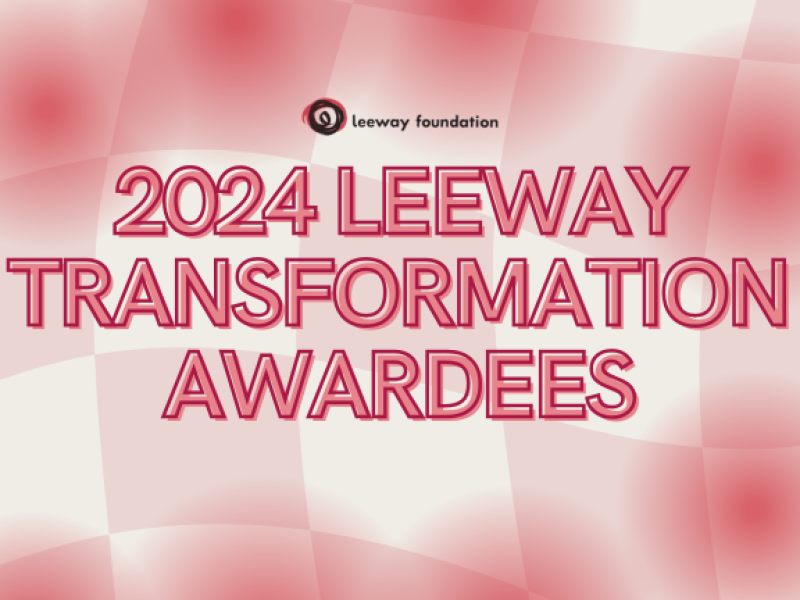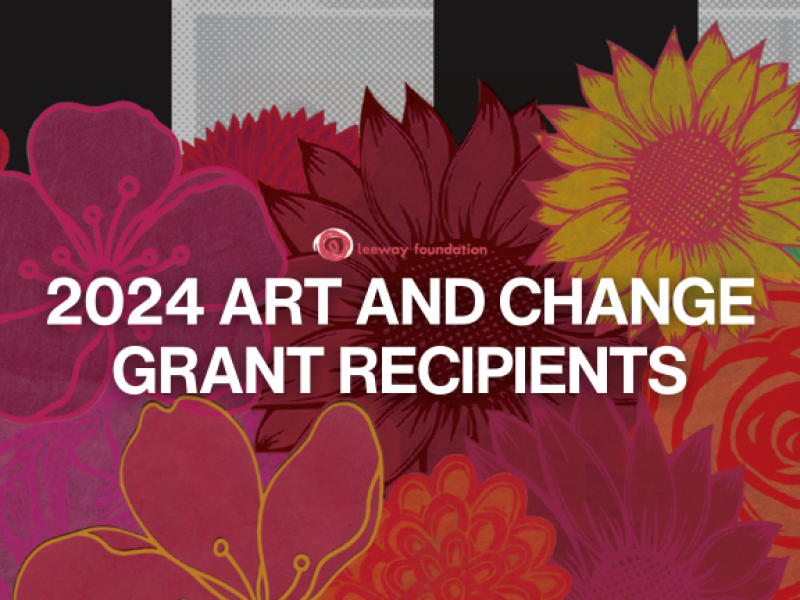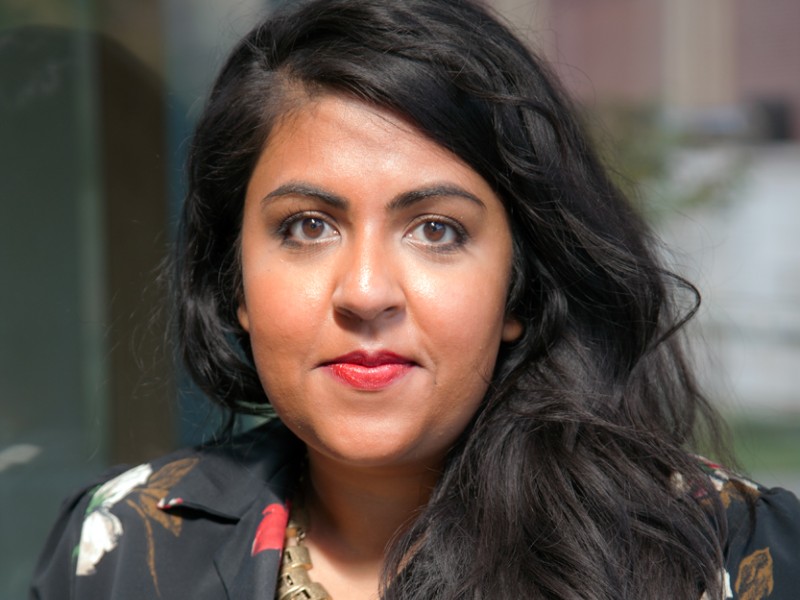Leeway @ 25: Interview with Rha Goddess

Interview by V Chaudhry, Leeway Scholar-In-Residence
How did Leeway come onto your radar and what brought you to the organization?
I knew you were going to ask me that question so I went to my head to think, “OK wait, where did I meet Denise?” I want to say I think Denise and I met at some kind of arts and culture gathering, it might have even been Creating Change by The Opportunity Agenda. This amazing advocacy organization based in New York, does an annual retreat where they bring together artists and change makers and funders and people from the for-profit sector and its really talking about all the different people who are pushing on culture. And I think that’s where I met Denise. And we just clicked. You know, just clicked; saying a lot of the same things, Amen-ing each other, fascinating each other. It began this really beautiful dialogue, and at the time, Leeway was really- Denise had been [executive director] for just a few years, and she was really wanting to bring the organization current in terms of its mission- so they had just gone through, or I think was planning on going through a major strategic planning process. She was looking at the board and doing development work and was sort of taking an audit of the foundation. And what the foundation was initially created for and in the way that the artistic community in Philadelphia had developed, even more particularly on the specific needs the artistic community of Philadelphia had developed, and she had a really keen eye for, even at the time, for people of color, for women, for genderfluid and gender nonconforming and trans LGBTQ+ folks. So that was always baked into her original thinking, as well as the way art was defined, and really starting to take a broader view of artisans in community in the context of community and the way they, through their craft, push on culture and that was sort of the opening “Hello! We’re thinking about these things. Can you come help us think about these things?” And I agreed. And I think I took part in some type of faciliatory process, where Denise had seen me work and was like, “I think we gotta make this work.” I also knew so many artists at the time. I’m semi-retired now we’ll talk about that later, but I had been practicing for a really long time and I had made work in various kinds of contexts and always with some type of social impact purview and commitment, which was, you know, what Leeway was leaning towards. While at the same time, kind of saying, “Hey listen, there are artists that do not define themselves as activists, but they are pushing on culture and they should have a seat at the table.” There’s something about preserving the practices and crafts and ways of art making that were evolving because of technology, but there is something to preserving, you know, the craft that feels special, cultural, some of those conversations as well. This ability to really think about how they define art, define its artists, and how they think about its mission, so that they really got clear about who they were serving and who they were putting out the call to. So that was really the impetus.
So what I am hearing is that you really helped envision the work of Denise and the organization. Denise points to you as someone who made a really big difference in putting together the Charge to Panelists before they come into the space and make decisions, make choices about which artists [receive Leeway’s grants]. Can you talk a little about that?
Yeah. A lot of that initial thinking evolved- we came up with something called The Anatomy of the Leeway Artist- and it was sort of these specific traits of what would make a Leeway artist. So, it was sort of broad in its casting, but very specific in what the artist would concern themselves with, what would the artist concern the world with, and most importantly, what would the artists concern people with, community with, thinking about the landscape of Philadelphia. That became sort of the foundation of the way the panel would be charged. Part of the thing that people bumped up against in the panels I was sitting on- it added fuel to the fire when we say it that way- how people held their own personal views and perspectives, and to what degree do people’s views and perspectives- meaning their aesthetic, their judgment of what was good art and bad art, their politics, who they think more space should be made for/ not made for, and how those things butt up against Leeway’s criteria- that was fascinating and I think that that’s what caused us to lean in and get really intentional about the charge to the panel because every time we put the panel together, it was like “there is a reason you are sitting at this table, there is a perspective, there is a purview. There is a lens that you bring, while at the same time, your lens has got to dance with our lens, because this is about our mission.” So how does that negotiation happen? That was a lot about what we talked about and what we talked though on our charge to the panel.
So, had you had arts funding experience in the past?
I did. I had the opportunity to work with NYFA (New York Foundation for the Arts), had the opportunity to work with New York Council for the Arts, so I had had the opportunity to be in the mix with other kinds of art foundations. I’ve worked with the Ford Foundation and the Future Aesthetics board - Roberta Uno’s first framework that then ultimately brought in LINC (Leveraging Investment in Creativity.). LINC (note: Launched as a ten-year initiative in 2003, LINC’s mission was to improve the ability of artists to create work, build social capital, and contribute to democratic values.) unfortunately no longer exists. I had worked with larger foundations, and with- then what they called- granting intermediaries. I had the chance to work with all kinds of those configurations and this was interesting in the sense of - in those organizations, a lot of it was different. Some of it was about framing the field- like with the Ford Foundation and Future Aesthetics- it was really about giving a voice to a future field of contemporary art that had not been named, that specifically carried the influence of hip hop artists, cause you know hip hop artists weren’t getting theater grants, they weren’t getting grants to make theater, and you know, Roberta Uno was the real pioneer in that for New World Theater back in the early 1990s Roberta was giving [inaudible] residencies, and giving Will Power residencies, and giving Rennie Harris residencies, way back in the day. And Rennie is a perfect example of a Philly-born-and-raised brilliant. I’m not telling anything you don’t know. Brilliant artist and choreographer and artistic director. Rennie was at a lot of those tables around how do you give voice to what the aesthetic was because it was a whole new art form. And I remember Rennie said, “what do you do when modern art isn’t modern anymore?” And that was like one of the big quotes. So, all that’s to say that I brought all of those purviews and perspectives, whether that was like, you know, giving voice to new art forms or incorporating new artists who didn’t look like the people who had been at the table for a really long time. Or, you know, for different kinds of initiatives, how to get art organizations to the degree that they were willing, with the times, and in some cases, innovating.
So where did you see Leeway fit in in terms of where art was going?
Always on the edge, I think Denise wanted it on the edge. To push the edge part of it was, you know, loving the fact that they were this smaller, you know, smaller artists grantmaking organization, she had a lot of autonomy to really think about how they could push the edge and I think it was everything from developing an aesthetic for their material, their collateral, their books, to really, what aspects of community are they going to go deeper around. And their thinking was really revolutionary in terms of LGBT queer, trans, other than maybe Astraea [Lesbian Foundation for Justice], who, I don’t know the director, but that amazing J. [Bob Alotta]. So, no one really other than Astraea at the time was pushing funding for that.
So that was the next question I was going to ask, sort of… in your world, or in the work you were doing, what did you see that was coming up in those questions? You mentioned there was this shift happening, especially early on when Denise had come in. You know, that was when the shift from being woman-focused expanded to women and trans/GNC folks. How did you witness that shift and what were some of the concerns that came up in terms of panelists and community members?
There was a lot of concern about the different kinds of art and art making. I’ll give you an example: a thirty-five-year-old sculptor- I should say- a sculptor who had been working thirty-five years, was working on some type of unique technique, versus an artist who had been doing graffiti for three years, trying to expand their art form, to a sister that did hair and trying to extend that to someone doing really intricate things with locks and braids, and how they were identifying themselves. There was a lot of intentionality around how they define, and named, and framed so people could see themselves inside of the definition. One thing they were interested in was who feels entitled to apply and why? There was something exciting about definitions that felt really accessible.
Even to someone who had never applied for a grant before who was doing incredible work, or incredible art at the intersection of community. With the LGBTQ+ community, it was the nomenclature, you know. I don’t need to tell you the nomenclature changes every week; either it expands, or it gets different. “Tsk, tsk, tsk- Trans is not the same as bi,” or “Tsk, tsk, tsk- trans is not the same as…” You know what I’m saying? And there’s medically transitioned and there’s blah, you know. A lot of it was, “Are we keeping up with the lexicon? Does it reflect the way the community sees itself? How do we lift up some of the most interesting art making that we think is happening in the community in a way that feels honoring instead of ‘oh yeah everything and the kitchen sink?’”
Yeah! And to think about what it means to fund trans communities…
You know, yeah, I think in that piece, recognizing the dearth of funding. So, what happens when you give someone a grant and they’re on an island, or it puts them on an island. You know, the way they have to leverage their resources looks very different than someone who is part of a whole ecosystem and field who can go to people and get things done in a very different way. There was a lot a lot of thinking done about that- how they [Leeway] think about partnerships, how they think about potential to raise matching or invite matching opportunities, or how to coach artists to think about matching opportunities. And, you know as always, how the money was used. Are you using it to live on? To make art?
I’ve done quite a few interviews with trans and GNC folks who have received Leeway funding, and its always interesting to see how they go about planning on using the money, what it has meant to share it with their communities. I think that’s really interesting. So, you also served as a panelist or facilitator?
Facilitator.
What was that like? Had you already been talking to panelists? As a facilitator, what were the things that were important for you? What were some of the standout conversations?
I mean I think even with the best intentions panels are subjective. Highly, highly, highly subjective. And I think owning that and being willing to own it. I say that because I think that sometimes when organizations put panels together, they don’t really think about that and it’s funny because when we were talking- this is really something that Denise and I were even talking about last week- about how she got invited to talk on a panel and she hadn’t really had clear guidance of how to come in. Because everyone comes into the room bringing whatever they bring. What struck me the most is that, okay, one sometimes you’re managing an ecosystem of personalities and ecosystems of different points of view, the ecosystem of how everyone gets a balanced voice. If some people are more outspoken or some people have more credentials, how do you make sure everyone gets a voice? How does this get weighed? How does the room get swayed in a decision? And I remember that on this particular panel, an artist being considered held a particular point of view that one of the panelists really, really struggled with, and the panel wound up going into deliberation for hours around how many grants the panel was going to give. The other, more provocative thing that Denise decided was that, “Yes, we can give 14 grants but we don’t have to.” And as a matter of fact, that panel did not give 14, they gave 12. And it’s like, “Oh my gosh! In arts, you would do that?” It was very provocative at the time! I don’t know how you can argue fair/not fair- if that artist makes incredible work, can a panel consider if an artist has already gotten five major grants that year? You know, spread the love? I just- I think that the thing that I walked away from coming through that process was the importance of transparency and how you, as a facilitator, encourage your panelists to get as transparent as you possibly can as early as you possibly can, so you get it out- where people are coming from at the beginning, and to the extent that panelists’ personal stories and purviews are crucial. There was context-setting work that was done so the panel got to know each other and where they were coming from before they went into deliberation, so they could do a different kind of listening. That felt kind of crucial. I don’t know how many other people do it, but that felt important to me. The walkaway for Leeway was really taking the time to curate the panel well. Another thing I’ll say is what became really apparent is Leeway’s ability to really help artists put together strong applications. And I think that any organization that approaches grantmaking as advocates has a commitment to trying to figure out how artists do that because some are more resourced than others. So, does the person with the prettier package get the grant? How do you make choices about capacity and commitment and rigor when you think about those things?
What other ways have you been involved with Leeway since? How has Leeway grown since your involvement?
You know it’s interesting, I’ve been away from it for a while. Just check-ins with Denise. And I know that in any conversation I’m having with her, she’s always thinking about Leeway’s work in relation to the field, and I will also say that was always baked in from the beginning. It wasn’t just being intentional with how Leeway was being operated in Philadelphia, but also how Leeway was being seen in the rest of the philanthropic field nationwide and worldwide. Denise has always thought about that, which is why Leeway has a presence that is bigger than just where they sit, and I think Denise being called into the arts and culture community about the very specific things that Leeway does is part of that as well. So I haven’t. I think the last time I received an annual report was probably about three or four years ago, I want to say. And I just remember it being stunning and smiling and remembering Denise talking about wanting them to look like works of art as they are an arts organization. I remember not wanting to throw it away because it literally looked like a piece of art and I just sat there- I remember sitting there being like, “Oh yeah, Denise and her commitment,” because you know, she just thinks so carefully.


